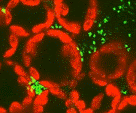Plant Pathology, Department of

Department of Plant Pathology: Faculty Publications
Document Type
Article
Date of this Version
7-12-2023
Citation
Nature Communications | ( 2023) 14:4146. https://doi.org/10.1038/s41467-023-39880-w
Abstract
The blast fungus Magnaporthe oryzae produces invasive hyphae in living rice cells during early infection, separated from the host cytoplasm by plantderived interfacial membranes. However, the mechanisms underpinning this intracellular biotrophic growth phase are poorly understood. Here, we show that the M. oryzae serine/threonine protein kinase Rim15 promotes biotrophic growth by coordinating cycles of autophagy and glutaminolysis in invasive hyphae. Alongside inducing autophagy, Rim15 phosphorylates NADdependent glutamate dehydrogenase, resulting in increased levels of α- ketoglutarate that reactivate target-of-rapamycin (TOR) kinase signaling, which inhibits autophagy. Deleting RIM15 attenuates invasive hyphal growth and triggers plant immunity; exogenous addition of α-ketoglutarate prevents these effects, while glucose addition only suppresses host defenses. Our results indicate that Rim15-dependent cycles of autophagic flux liberate α-ketoglutarate – via glutaminolysis – to reactivate TOR signaling and fuel biotrophic growth while conserving glucose for antioxidation-mediated host innate immunity suppression.


Comments
Open access.